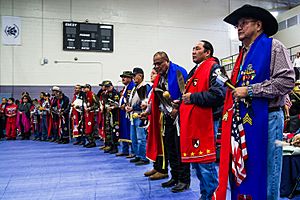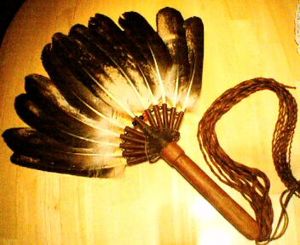Gourd Dance facts for kids
The Gourd Dance is a special social dance with deep roots in Native American culture, especially among the Kiowa people. It's a dance that brings communities together and honors traditions.
Contents
The Story of the Gourd Dance
The Gourd Dance has a special origin story from the Kiowa tribe. One story tells of a young man who was lost and alone. He was very hungry and thirsty. He came to a hill and heard amazing singing.
On the other side of the hill, he saw a red wolf singing and dancing. The man watched and listened all day and night. When morning came, the wolf spoke to him. The wolf told him to share the dance and songs with his people, the Kiowa.
Today, the "howl" at the end of each Gourd Dance song honors that red wolf. Long ago, the Kiowa Gourd Dance was part of the Kiowa Sun Dance ceremony.
A Dance Returns: Revival and Groups
Starting in 1890, the United States government tried to stop many Kiowa cultural practices. By the late 1930s, the Gourd Dance was not often performed.
In 1957, a man named Fred Tsoodle helped bring the dance back. He asked singers Bill Koomsa and William Tanedooah, who remembered the old songs, to perform. Other Kiowa men also danced in traditional clothing. This special presentation helped spark new interest.
Two years later, several Kiowa men officially restarted the Kiowa Gourd Dance Society. This happened on January 30, 1957. Later, this group split into three main organizations. These groups hold their yearly dances around July 4th. This date is chosen because the Gourd Dance was once part of the summer Sun Dance.
The names of some Gourd Dance groups come from "Jài:fè:gàu," which was a Kiowa warrior society. Because of this, some people mistakenly think the Gourd Dance is only for veterans. However, leaders of these groups agree that you do not need to be a veteran to join.
Who Participates in the Gourd Dance?
The Gourd Dance began with the Kiowa tribe. It is mainly a men's dance. Women also take part by dancing in place behind the men. They stay outside the main circle formed by the men. In the Kiowa language, the dance is called "Ti-ah pi-ah." This means "ready to go, ready to die."
The Kiowa people see this dance as their own special dance, given to them by the "Red Wolf." Over time, it has spread to many other tribes and groups. Many participants are older men. The Gourd Dance is less energetic and physically demanding than other pow-wow dances.
Some Gourd Dances last all afternoon and into the evening. When it gets cooler, more energetic Intertribal dances might begin. Some tribal gatherings feature only Gourd Dancing.
What Dancers Wear: Regalia
Modern Gourd Dance clothing, called regalia, is very special. Dancers wear a red and blue blanket over their shoulders. This blanket represents night and day. Some dancers move the blanket to rest over their heart, showing red during the day and blue after dark.
Dancers also wear a beaded bandolier, which is like a sash, across their chest. It is made of red skunk berries and silver beads. This red color remembers a battle where the land was covered in blood. A small bundle of Indian perfume, made from plants, is tied to the back of the bandolier.
Dancers hold a metal rattle in one hand and a feathered fan in the other. These are used to keep time with the drum. Kiowa Gourd Clan members usually do not use real gourds in this dance. This is because real gourds are used in other Native American Church ceremonies.
Traditionally, gourd dancers wore buckskin leggings and a long, red breechcloth. They also wore a black fringed shawl. Today, dancers often wear a long-sleeved shirt and a bolo tie with these items.
For headwear, dancers might wear hair wraps made of otter fur, or a special cap called a roach or otter cap. It is considered disrespectful to wear things like ball caps, T-shirts, cowboy hats, or boots while dancing. The leaders of the Kiowa Gourd Dance society ask members to dress with respect.
Music and How the Dance is Performed
Like other pow-wow dances, the Gourd Dance happens in a circular area. The drum can be placed on the side or in the center of this area. Dancers stand around the edge of the circle.
During most of the song, dancers move in place. They lift their feet to the beat of the drum and shake their rattles from side to side. At certain times in the song, the drum beats become stronger. At these moments, the dancers will dance in place with more energy. When the beats become softer, dancers will move a short distance from their spots.
The dance usually starts in the afternoon with an "Opening Song." The lead singer decides how many songs are sung in a set. The songs often start slower and get faster as the dance continues. A fast song is usually played near the end, but it is not the official closing song. Sometimes, buffalo songs are sung after the last Gourd Dance song.



